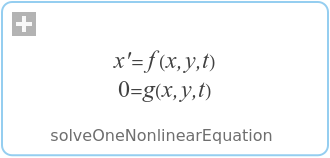WOLFRAM SYSTEM MODELER
solveOneNonlinearEquationSolve f(u) = 0; f(u_min) and f(u_max) must have different signs |
|
Wolfram Language

SystemModel["Modelica.Blocks.Continuous.Internal.Filter.Utilities.bandPassAlpha.solveOneNonlinearEquation"]

Information
This information is part of the Modelica Standard Library maintained by the Modelica Association.
This function determines the solution of one non-linear algebraic equation "y=f(u)" in one unknown "u" in a reliable way. It is one of the best numerical algorithms for this purpose. As input, the nonlinear function f(u) has to be given, as well as an interval u_min, u_max that contains the solution, i.e., "f(u_min)" and "f(u_max)" must have a different sign. If possible, a smaller interval is computed by inverse quadratic interpolation (interpolating with a quadratic polynomial through the last 3 points and computing the zero). If this fails, bisection is used, which always reduces the interval by a factor of 2. The inverse quadratic interpolation method has superlinear convergence. This is roughly the same convergence rate as a globally convergent Newton method, but without the need to compute derivatives of the non-linear function. The solver function is a direct mapping of the Algol 60 procedure "zero" to Modelica, from:
- Brent R.P.:
- Algorithms for Minimization without derivatives. Prentice Hall, 1973, pp. 58-59.
Syntax
Inputs (6)
| aa |
Type: Real |
|---|---|
| bb |
Type: Real |
| ww |
Type: Real |
| u_min |
Type: Real Description: Lower bound of search interval |
| u_max |
Type: Real Description: Upper bound of search interval |
| tolerance |
Default Value: 100 * Modelica.Constants.eps Type: Real Description: Relative tolerance of solution u |
Outputs (1)
| u |
Type: Real Description: Value of independent variable so that f(u) = 0 |
|---|
